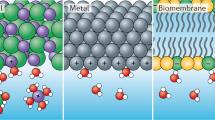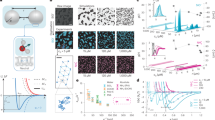Abstract
Our experiment1 provides a clear measure of the interactions between charged particles at fluid–fluid interfaces and demonstrates that there can be a long-range attractive interaction between such particles.
Similar content being viewed by others
Nikolaides et al. reply
However, Megens and Aizenberg raise important points about our interpretation of these results. Our calculations account for the electrostatic stresses acting on the fluid–fluid interface, but neglect the force that the electric field exerts on the particle itself. A detailed evaluation of this force, obtained by calculating the change in electrostatic energy as the particle is pushed into the fluid, shows that the interfacial force pulling the particle out of the fluid is exactly cancelled by the electrical force pushing the particle into the fluid, in agreement with the suggestion of Megens and Aizenberg.
This creates a puzzle: the data show unambiguously that there is a long-range attraction, but what is its origin? The particles have a long-range repulsive interaction, owing to their charges; this is dipolar in character, with the electrostatic energy decaying as 1/r3. The attractive interaction must balance this electrostatic repulsion, so, if it decays as a power law, the attractive interaction energy must decay more slowly than 1/r3 to create the stable energy minimum observed experimentally. This eliminates possibilities such as asymmetries in the contact line or fluctuation-induced forces, all of which have a power-law decay that is more rapid than 1/r3. The most likely interaction that has sufficient range therefore remains capillary distortion of the interface.
Capillary distortion can occur only if there is an imbalance between the force pulling the particle into the water and the force pushing the interface outwards towards the oil. However, it is sufficient for these forces to be imbalanced only up to distances comparable to the interparticle separation: this would still lead to distortion of the interface between the particles, causing the attractive force. The resolution of the puzzle could lie in charges on the particles on the oil side, rather than on the water side2. As the density of free charges in oil is much lower than that in water, the screening length is correspondingly larger; this significantly extends the range of the force imbalance and can account for our experimental observations. The origin of the capillary distortion therefore remains electrostatic in nature.
We have since confirmed that the particles do have a measurable charge, even when immersed in oil. Measurements of the electrophoretic mobility and pair correlation functions of these particles indicate that their charge can be as high as 200e in oil. In the absence of additional solubilized charges, this would result in a screening length of the order of 20 μm for the particle volume fraction of about 10−4 used in our experiments. This is larger than the particle separation, allowing the force imbalance between the particle and the interface to persist far enough for significant interfacial distortion to exist at scales comparable to the interparticle separation. We therefore believe that electric-field-induced capillary distortion remains the likely culprit for the attractive interactions between like-charged interfacial particles.
References
Nikolaides, M. G. et al. Nature 420, 299–301 (2002).
Aveyard, R. et al. Phys. Rev. Lett. 88, 246102-1-4 (2002).
Author information
Authors and Affiliations
Corresponding author
Rights and permissions
About this article
Cite this article
Nikolaides, M., Bausch, A., Hsu, M. et al. Like-charged particles at liquid interfaces. Nature 424, 1014 (2003). https://doi.org/10.1038/4241014b
Issue Date:
DOI: https://doi.org/10.1038/4241014b
Comments
By submitting a comment you agree to abide by our Terms and Community Guidelines. If you find something abusive or that does not comply with our terms or guidelines please flag it as inappropriate.



